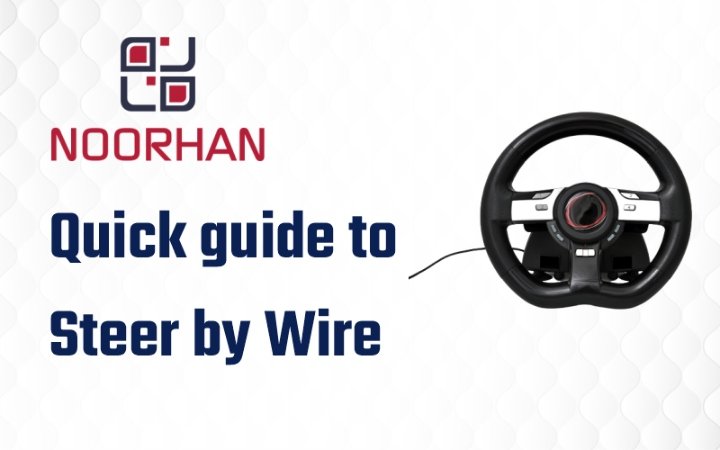Driving Smarter With Steer-By-Wire Systems
The automotive industry is changing, or should we say ‘evolving.’ As the technology matures, it’s only a matter of time before driverless cars become the norm. The steer-by-wire system or electronic steering is one crucial step in that direction.
Traditionally, steering systems in vehicles had mechanical connections to link the driver’s input with the movement of the wheels. However, steer-by-wire replaces this mechanical connection with electronic controls offering many benefits with a few challenges.
Love it or not, fully autonomous cars are going to take over the scene in the coming years. If you’re curious about this electronic steering wizardry and how it compares to the traditional steering system, this is the blog for you. Let’s dive deep into this technology and understand this concept in and out.
What is Steer-By-Wire?
Steer by wire, commonly known as electronic steering, is a cutting-edge technology that removes the necessity for mechanical links to connect a vehicle’s steering wheel to its tires.
This automatic system uses electronic sensors to detect the driver’s input and transmit signals to an electronic control unit (ECU) as opposed to depending on physical connections. After analyzing these signals, the ECU instructs the electric motors to turn the wheels. This cutting-edge method represents a remarkable improvement from the traditional mechanical steering techniques.
History of Steer-By-Wire
Speaking of steering systems, traditional methods have been around for as long as we can remember. But, with the “Steer by Wire” pulling up like a new guy to the scene, let’s see what benefits it has to offer to us gearheads.
Enhanced Safety
SBW reduces the possibility of steering-related mishaps brought on by jammed or locked steering columns by removing the physical link between the handwheel and the tires.This technology can make driving safer, especially if you’re a senior citizen or a differently-abled person. Driving will be a lot smoother for you since drive-by-wire will filter out vibration feedback on bumpy roads.
However, we would say that the standout safety feature of drive-by-wire is the precision it offers. You can make really sharp turns around tight corners without moving the hand wheel a lot as you do while parking your vehicle. Real-time data transmission made possible by this electronic connection enables the car to make intelligent, autonomous steering decisions in challenging driving situations. This prevents the possibility of accidents.
Improved Fuel Efficiency
Fuel economy has become a crucial element of vehicle design as we move towards a more sustainable and greener environment. Steer by wire system reduces the amount of energy required to steer the vehicle thereby improving fuel efficiency and reducing emissions.Additionally, there are fewer mechanical components present in the drive-by-wire system which means that it requires less fuel. As this system is electronic, you can combine it with other advanced technologies found in hybrid and fully electric vehicles that save energy. This will make sure that your car remains fuel-efficient while also performing well on the road.
Designing freedom
Steering systems with steer-by-wire technology don’t require as many mechanical parts as those with conventional steering systems. There will be more room within the cabin, giving automobile designers more creative freedom to make use of it.The steering wheel can be placed anywhere, so automakers won’t have to design unique steering systems for vehicles with a left- and right-hand drive.
This additional independence allows car designers to develop original and inventive interior designs. It provides designers the option to create a driving environment that is genuinely unique, whether that means adding new features, giving the impression of extra space, or experimenting with imaginative ideas.
Reduced maintenance and weight
A traditional steering system’s mechanical parts deteriorate with time and need repair on a regular basis. However, as sensors are taking their place, you will require less maintenance because electronic parts are typically more resilient. Although steer-by-wire technology initially appears to be an expensive alternative, it ultimately costs less.As you remove the heavy mechanical steering components, the vehicle’s weight is also lowered, improving handling, acceleration, and overall performance. SBW enables automakers to create lighter, more efficient, and ecologically friendly vehicles by reducing unnecessary weight.
Steer-By-wire: Challenges and concerns
One major worry with this electronic steering system is that if the software malfunctions or there is a transmission error, you could have an accident. Because of this, the majority of modern cars have backup systems that can rescue the day in an emergency.
Power problems will also have an impact on how effective this system is. You’ll be in trouble if this system has an electrical failure. Additionally, this method of steering consumes more energy than a mechanical steering wheel.
One common problem with advanced technology is the cost. Since drive-by-wire systems replace mechanical parts with actuators and sensitive cables, they will surely be more expensive to install and take care of than their conventional counterparts. Drive-by-wire systems, however, are less prone to malfunction than traditional steering wheel systems since they are built with fewer mechanical parts.
Loss of Feedback And Connection With Steer-By-Wire
One reason that some people are against this electronic steering system is that it takes away the feedback and connection between the driver and the vehicle.
Some people enjoy driving because they get a sense of control and feel involved with the road. The vibration of wheels, the movement of tires, and the suspension’s response, everything has a feel. You can better estimate the car’s distance, direction, and speed thanks to it. Steer-by-wire would make us feel more like we were operating a remote-controlled vehicle than a genuine automobile.
Steer-By-Wire in Driverless Cars
Imagine cars that can drive themselves – that’s what we call fully automatic cars. These cars use smart computers and sensors to navigate without any human input.
Steer-by-wire and self-driving technology mix together like peanut butter and jelly. The smart system helps the self-driving car go where it’s supposed to go, without a human driver. And if something goes wrong, backup plans kick in to keep the car safe. So, when you see those futuristic cars driving themselves, remember that the cool steer-by-wire system is a big part of making it happen!
What Vehicles Already Have Steer-By-Wire Technology?
Steer-by-wire first appeared in the 2014 Infiniti Q50 sedan and is now an option for the QX50 and QX55 compact crossovers and the Q60 coupe. Infiniti named it Direct Adaptive Steering, highlighting that it’s not affected by the traditional steering issues.
Outside the United States, the Toyota bZ4X electric crossover will use steer-by-wire. This system lets the front wheels move fully with just a small turn (150 degrees) of the steering wheel. Regular cars need more turns for this. The Subaru Solterra EV, similar to the bZ4X, won’t have this system in the U.S.
Steer-by-wire is also used for better rear-wheel steering, which improves how the vehicle moves. The GMC Hummer EV and upcoming Chevrolet Silverado EV use this technology for improved maneuvering and handling.
Exploring the Future of Steer-By-Wire
Steer-by-wire technology adoption has been delayed by safety concerns. Despite the fact that mechanical systems can and do fail, regulatory bodies nonetheless consider them to be more reliable than electronic ones. These electronic systems are also more expensive due to the fact that they are substantially more sophisticated than mechanical controllers.
This advanced technology, however, may bring about a number of intriguing new innovations in the future. Automakers might be able to create vehicles that are vastly different from the cars and trucks that are currently on the road if mechanical controls are eliminated. Since the driver’s position is not determined by mechanical controls, concept automobiles like the Hy-Wire have even made it possible to rearrange the seating arrangement.
Driverless car technology, which enables vehicles to be operated remotely or by a computer, might also be combined with this technology.



























































